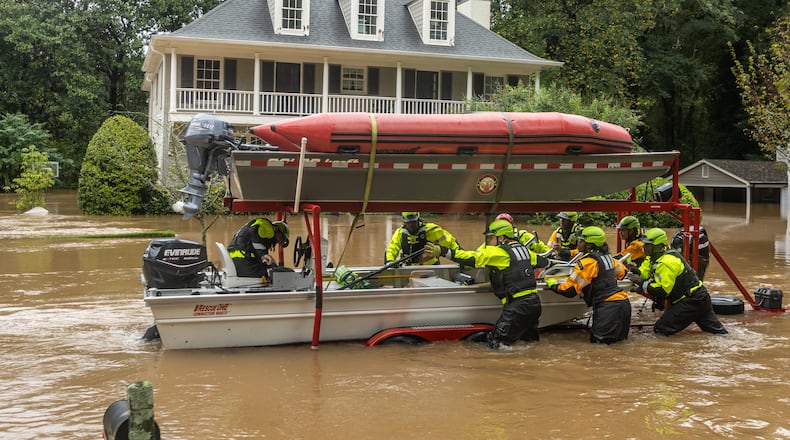Early last week, the tropical disturbance that became Hurricane Helene was a disorganized cluster of thunderstorms off the coast of Cuba. Three days later, Helene had exploded into a Category 4 hurricane packing winds of 140 mph as it hurtled toward Florida’s Gulf Coast.
The storm was the strongest on record to strike Florida’s Big Bend region. It maintained its hurricane-force winds deep into Georgia and dropped record-breaking rains on parts of the state, as well as the Carolinas, Tennessee and Virginia, where devastating floods wiped entire towns off the map.
The full scope of the damage Helene left behind is still coming into focus, but the storm already ranks as one of the most destructive in U.S. history. More than 160 people have been confirmed dead, with hundreds still missing, as responders sort through the wreckage. Damage caused by the storm could be $160 billion, according to estimates from AccuWeather.
While the Atlantic Basin has produced hurricanes for millennia, Helene exhibited traits scientists say are becoming more common as human activity warms the planet.
Here’s what we know — and don’t know — about how climate change made Helene more destructive.
Wetter storms
Global temperatures have risen by an average of 2 degrees since 1850 and scientists have known for decades that warmer air holds more moisture, which leads to wetter storms. Experts say Helene’s extreme rainfall is among the clearest indications of climate change’s influence.
The amount of rain Helene dumped across a huge swath of the Southeast was unprecedented, at least since humans have been keeping track.
Beginning last Wednesday, Helene — along with a rainstorm that soaked Atlanta just before the main event — combined to drop more than 11 inches of rain on the metro area, the most on record for a 48-hour period.
As the storm rose over the southern Appalachian Mountains, the change in elevation wrung even more moisture out of the storm, shattering rainfall records in places like Asheville, North Carolina, and many other locations.
Michael Wehner, a senior scientist at California’s Lawrence Berkeley National Laboratory, said he and his colleagues conducted a “climate change attribution” analysis of the storm’s rainfall, seeking to determine how global warming contributed to the event. Their preliminary findings show the rainfall totals observed in parts of Georgia and the Carolinas were made about 20 times more likely because of human-caused global warming.
The authors estimate climate change “may have caused as much as 50% more rainfall” in parts of Georgia, North Carolina and South Carolina, and perhaps an even larger role boosting the deluges that fell in the hardest hit areas, but more analysis is needed.
The study has not been peer reviewed, but the same methods have been used to investigate other major storms, like hurricanes Harvey and Dorian.
“We’ve looked at this a lot and without exception, for the big storms, we’ve found there’s a substantial human influence on rainfall,” Wehner said.
Rapid intensification
As human activity has warmed the planet, the vast majority of the excess heat — about 90%, according to the National Oceanic and Atmospheric Administration — has been absorbed by the world’s oceans.
Ocean heat, meanwhile, is the primary fuel for hurricanes and can allow storms to rapidly intensify.
Data shows the waters Hurricane Helene passed over in the Gulf of Mexico as it barreled toward Florida were the hottest on record for this time of year. And while scientists say it’s too early to say climate change caused Helene to balloon from a Category 1 to a Category 4 storm before it made landfall, the storm’s swift increase in intensity fits with observed trends.
A 2022 study published in the peer-reviewed scientific journal Nature Communications found a growing number of cyclones have rapidly intensified since the 1980s, and determined that rising global temperatures are contributing.
“While the timing of rapid intensification is pretty hard to forecast, we know pretty well that it’s linked to sea surface temperatures,” said Kevin Reed, a professor in the School of Marine and Atmospheric Sciences at Stony Brook University in New York.
Higher seas = Worse storm surge
The melting of the world’s glaciers and ice sheets from human-caused warming is contributing to rising sea levels observed around the globe.
Since the 1880s, global sea levels have increased by an average of 8 to 9 inches. In certain places, including along the U.S.’ Gulf and Atlantic coasts, they’re rising even faster.
That increase in sea levels is leading to more nuisance flooding during high tide, including in Georgia. But when massive storms like Helene crash into the coast, those few extra inches allow storm surge to penetrate farther inland, placing more property and lives at risk.
Along with inland flooding, storm surge is among the most dangerous and destructive impacts of hurricanes. It’s not clear yet exactly how high the water rose in places like Perry, Florida, near where Helene made landfall, but videos show the storm’s surge caused devastating flooding in many coastal towns.
More hurricanes?
Will rising ocean temperatures lead to more hurricanes striking the U.S.? Maybe not.
According to the Fifth National Climate Assessment, the U.S. government’s most comprehensive report on climate change and its impacts, there is no discernible trend in the frequency of hurricane landfalls in the U.S. since the late 19th century. There’s even less evidence to support the notion that more storms will strike Georgia.
Still, there are other changes in hurricane behavior researchers are exploring, which could have an impact in Georgia.
Once over land and cut off from their main fuel supply, hurricanes loose strength. But since the 1960s, some research has found storms are not decaying as quickly after landfall, potentially allowing impacts to stretch farther inland.
Part of the reason Helene was so destructive is the storm moved relatively quickly over land, allowing it to maintain its powerful winds as it moved across Georgia. But the storm’s sheer size — a Category 4 with a wind field spanning hundreds of miles — is probably a better explanation for why this particular storm was able to maintain momentum over land, Reed said.
“A stronger storm is just inherently going to be able to stay at Category 1 or above longer after it makes landfall, so I think that’s probably a bigger factor with this event,” Reed said.
Credit: AP
Credit: AP
Other research has found a growing number of storms are stalling out once ashore, which tends to drive up rainfall amounts and flood risks. Hurricane Debby, which swamped the Georgia and Carolina coasts just weeks ago, is one of several slow movers that have struck the U.S. recently.
Experts says those trends merit more investigation, but it’s too soon to say the changes are caused by global warming.
A note of disclosure
This coverage is supported by a partnership with Green South Foundation and Journalism Funding Partners. You can learn more and support our climate reporting by donating at ajc.com/donate/climate.
About the Author
Keep Reading
The Latest
Featured





